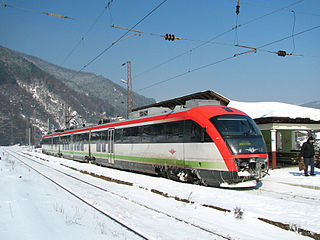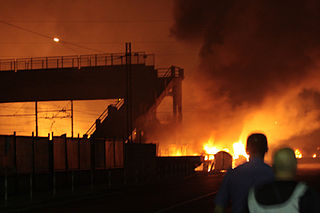
Transport in Bulgaria is dominated by road transport, despite nearly half of all paved roads belonging to the lowest category of roads. As of December 2015, the country had 829 kilometers of highways.

Pakistan Railways is the national, state-owned railway company of Pakistan in Lahore. Founded in 1861 as the North Western State Railway and headquartered in Lahore, it owns 7,791 kilometres of operational track across Pakistan, stretching from Torkham to Karachi, offering both freight and passenger services, covering 625 stations across Pakistan.

The Class 66 is a type of six-axle diesel-electric freight locomotive developed in part from the Class 59, for use on the railways of the UK. Since its introduction the class has been successful and has been sold to British and other European railway companies. In Continental Europe it is marketed as the EMD Class 66 (JT42CWR).

The Mississauga train derailment, also known as the Mississauga Miracle, occurred on November 10, 1979, in Mississauga, Ontario, Canada, when a CP Rail freight train carrying hazardous chemicals derailed and caught fire. More than 200,000 people were evacuated in the largest peacetime evacuation in North America until Hurricane Katrina. The fire was caused by a failure of the lubricating system. No deaths resulted from the incident.
Kaspichan is a town in central northeastern Bulgaria, part of Shumen Province. It is located in the eastern Danubian Plain, some 70 km (43 mi) from the major Black Sea port Varna and around 120 km (75 mi) from the key Danube ports of Ruse and Silistra. As of December 2009, the town has a population of 3,260 inhabitants.

The DSB Class EA was the first electric locomotive in Denmark, introduced in 1984. Twenty-two were built for DSB, about half were acquired by Deutsche Bahn in 2001 when it took over the freight business of DSB.

The 2008 Chelopechene explosions were a series of explosions that began early on Thursday morning 3 July 2008 at around 6:30 am local time at a munitions depot in the suburb of Chelopechene, 10 kilometres east of the centre of the Bulgarian capital, Sofia. The initial explosions were powerful enough to be heard in the entire capital and surrounding villages. The depot was part of a military facility that specialised in dismantling obsolete ammunition.
Hitrino is a village in northeastern Bulgaria, part of Shumen Province. It is the administrative centre of the homonymous Hitrino Municipality, which lies in the northwestern part of the province.

The Viareggio derailment was the derailment and subsequent fire of a freight train carrying liquefied petroleum gas. It occurred on 29 June 2009 in a railway station in Viareggio, Lucca, a city in Central Italy's Tuscany region. Thirty-two people were killed and a further twenty-six were injured.
Rail World is a rail transport holding company. Its specialties include railway management, consulting, investment, privatizations, and restructurings. Its purpose is to promote rail industry privatization by bringing together government bodies wishing to sell their stakes with investment capital and management skills.

The Lac-Mégantic rail disaster occurred in the town of Lac-Mégantic, Quebec, Canada, on July 6, 2013, at approximately 1:14 a.m. EDT, when an unattended 73-car Montreal, Maine and Atlantic Railway (MMA) freight train carrying Bakken Formation crude oil rolled down a 1.2% grade from Nantes and derailed downtown, resulting in the explosion and fire of multiple tank cars. Forty-seven people were killed. More than thirty buildings in Lac-Mégantic's town centre were destroyed, and all but three of the thirty-nine remaining buildings had to be demolished due to petroleum contamination. Initial newspaper reports described a 1 km (0.6-mile) blast radius.

Edward Arnold Burkhardt is a railroad executive, the founder and current chairman of Rail World Inc.

Europhoenix is a spot-hire railway locomotive company in England. In addition to the hiring out of locomotives to various other operators across the United Kingdom, it commonly exports former British Rail rolling stock to operators in mainland Europe.
The rail war began in different regions of Russia in the spring of 2022 after a similar rail war in Belarus.










